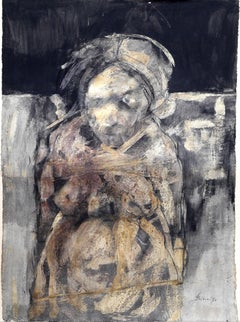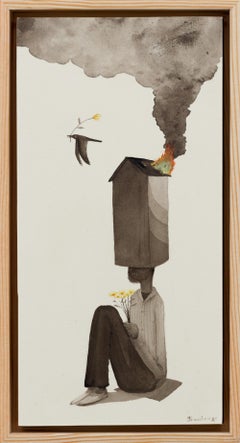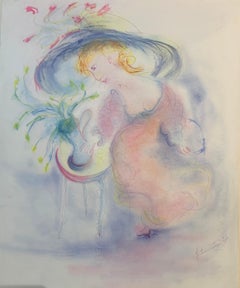Armando L. Balboni Art
to
1
Overall Width
to
Overall Height
to
1
1
1
1
1
1
1
1
1
1
1
1
1
10,043
2,758
1,381
1,375
1
Artist: Armando L. Balboni
Domini, Watercolor and Encaustic Painting by Armando Balboni
By Armando L. Balboni
Located in Long Island City, NY
Artist: Armando L. Balboni
Title: Domini
Year: 1970
Medium: Watercolor with Wax, signed and dated l.r.
Size: 40 x 27.5 inches
Category
1960s Modern Armando L. Balboni Art
Materials
Watercolor, Wax
Related Items
"A Cut Flower Can't Last I" Smoke and House Imagery in Grayscale Watercolor
Located in Philadelphia, PA
This piece titled "A Cut Flower Can't Last I" is an original piece by Graham Franciose, and is made from watercolor on panel mounted Rives BFK cotton rag, wax sealed, custom Douglas ...
Category
21st Century and Contemporary Contemporary Armando L. Balboni Art
Materials
Watercolor, Cotton, Wax, Wood Panel
$700
H 13 in W 7 in D 2.5 in
Antonio Monasterio – Woman with a Large Hat and Table with Vase. Nr.2
Located in Firenze, IT
Antonio Monasterio – Woman with a Large Hat and Table with Vase. Nr.2
• Technique: Mixed media on paper (pastels, wax, and red pen)
• Dimensions: 56 x 44 cm
• Signature: Lower ri...
Category
Late 20th Century Surrealist Armando L. Balboni Art
Materials
Paper, Crayon, Wax Crayon, Wax, Pen
$80 Sale Price
20% Off
H 22.05 in W 17.33 in
"A Cut Flower Can't Last II" Figure with Flowers and House in Flames
Located in Philadelphia, PA
This piece titled "A Cut Flower Can't Last II" is an original piece by Graham Franciose, and is made from watercolor on panel mounted Rives BFK cotton rag, wax sealed, custom Douglas...
Category
21st Century and Contemporary Contemporary Armando L. Balboni Art
Materials
Watercolor, Wax, Wood Panel, Paper
$700
H 13 in W 7 in D 2.5 in
"Manhattan Bridge" NYC American Scene Modernism Watercolor WPA Urban Realism
By Reginald Marsh
Located in New York, NY
Reginald Marsh "Manhattan Bridge" NYC American Scene Modernism Watercolor WPA Urban Realism, 20 x 14 inches. Watercolor and pencil on paper, 1938. Signed...
Category
1930s American Modern Armando L. Balboni Art
Materials
Paper, Watercolor, Pencil
$55,000
H 26 in W 20 in D 2 in
Philippe Noyer [Untitled] circa 1965 Signed Watercolor Portrait on Paper
By Philippe Henri Noyer
Located in Miami, FL
PHILIPPE NOYER – UNTITLED
⚜ Watercolor on Paper ⚜ Hand Signed Upper Right ⚜ Conservation Frame
PORTRAIT STUDY IN WATERCOLOR
Created circa 1965, this delicate watercolor by Philippe ...
Category
1960s Modern Armando L. Balboni Art
Materials
Paper, Watercolor
$3,000
H 33.125 in W 27.125 in D 1.25 in
Glassblowers WPA American Scene Mid- 20th Century Modern Figurative Workers 1932
By Harry Gottlieb
Located in New York, NY
Glassblowers WPA American Scene Mid- 20th Century Modern Figurative Workers. Dated and signed "32 Harry Gottlieb" lower right. Sight: 13 1/8" H x 18 1/4" W.
Harry Gottlieb, painter, screenprinter, educator, and lithographer, was born in Bucharest, Rumania. He emigrated to America in 1907, and his family settled in Minneapolis. From 1915 to 1917, Gottlieb attended the Minneapolis Institute of Arts. After a short stint as an illustrator for the U.S. Navy, Gottlieb moved to New York City; he became a scenic and costume designer for Eugene O"Neill's Provincetown Theater Group. He also studied at the Philadelphia Academy of Fine Arts and the National Academy of Design.
He was one of America's first Social Realist painters, influenced by that Robert Henri-led movement in New York City where Gottlieb settled in 1918. He was also a pioneer in screen printing, which he learned while working for the WPA. He married Eugenie Gershoy, and the couple joined the artist colony at Woodstock, New York. He lectured widely on art education.
In 1923, Gottlieb settled in Woodstock, New York and in 1931, spent a a year abroad studying under a Guggenheim Fellowship.
In 1935, he joined the Federal Art Project...
Category
1930s American Modern Armando L. Balboni Art
Materials
Paper, Gouache
Harry GottliebGlassblowers WPA American Scene Mid- 20th Century Modern Figurative Workers 1932, 1932
$4,400
H 21 in W 26 in D 2 in
"Animated Discourse" WPA Mid-Century American Scene Modernism Realism Figurative
Located in New York, NY
"Animated Discourse" WPA Mid-Century American Scene Modernism Realism Figurative.
Chris Ritter (American, 1906 – 1976) "Animated Discourse," 19 x 24 (sight). Watercolor on paper. Si...
Category
1940s American Modern Armando L. Balboni Art
Materials
Paper, Watercolor
$6,500
H 30 in W 34 in D 2 in
Bernard BOUTET DE MONVEL (1881 - 1949), "Portrait of Miss Lise Brissaud"
Located in Paris, FR
Bernard Boutet de Monvel was a French painter, sculptor, engraver, fashion illustrator and interior decorator. Although first known for his etchings, he earned notability for his pai...
Category
1920s Modern Armando L. Balboni Art
Materials
Paper, Watercolor, Pencil
$29,965
H 17.33 in W 17.33 in
"SOMEWHERE ELSE #2", Watercolor on Sal Leaf Plate, Black Frame, Green, Red, Tan
By Eva Ennist
Located in Toronto, Ontario
Eva Ennist, a mixed media and fiber artist, travels extensively through the Far East, gathering materials and techniques for her practice. The artwork "SOMETHING ELSE #2" uses materi...
Category
21st Century and Contemporary Naturalistic Armando L. Balboni Art
Materials
Watercolor, Organic Material, Wood, Found Objects, Mixed Media
$900
H 16 in W 16 in D 2 in
"The opium smoker", Léa Lafugie (1890-1972)
Located in Paris, FR
Léa Lafugie (1890–1972) was a painter who traveled extensively across Asia. She was renowned for her portraits. She studied at the School of Decorative Arts, followed by the École de...
Category
1920s Modern Armando L. Balboni Art
Materials
Watercolor
Madera Canyon Cycle - Grasses 1
By Suzi Davidoff
Located in New Orleans, LA
Davidoff creates drawings, paintings, prints and installations that consider intricate patterns in nature and the overlaying systems used to observe, map and define organic landscape...
Category
21st Century and Contemporary Contemporary Armando L. Balboni Art
Materials
Charcoal, Paper, Wax
“Six Figures, c. 1965-70” by Sakti Burman (b. 1935) Indian Folklore Watercolor
By Sakti Burman
Located in Yardley, PA
“Six Figures, c. 1965-70” by Sakti Burman (b. 1935).
A wonderful example of Burman’s distinctive fusion of Indian folkloric imagery with European surrealist and fantastical sensibil...
Category
1960s Modern Armando L. Balboni Art
Materials
Paper, Ink, Watercolor
$6,950
H 31.5 in W 37.5 in D 1.5 in
Armando L. Balboni art for sale on 1stDibs.
Find a wide variety of authentic Armando L. Balboni art available for sale on 1stDibs. You can also browse by medium to find art by Armando L. Balboni in organic material, paint, watercolor and more. Much of the original work by this artist or collective was created during the 1960s and is mostly associated with the modern style. Not every interior allows for large Armando L. Balboni art, so small editions measuring 28 inches across are available. Customers who are interested in this artist might also find the work of Florence E. Nosworthy, Frank Mason, and Robert Noel Blair. Armando L. Balboni art prices can differ depending upon medium, time period and other attributes. On 1stDibs, the price for these items starts at $3,850 and tops out at $3,850, while the average work can sell for $3,850.


